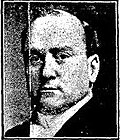Top Qs
Timeline
Chat
Perspective
Ynys Môn (UK Parliament constituency)
Parliamentary constituency in the UK From Wikipedia, the free encyclopedia
Remove ads
Ynys Môn (Welsh pronunciation: [ˌənɨs ˈmoːn]; officially called Anglesey until 1983) is a constituency of the House of Commons of the Parliament of the United Kingdom. It elects one Member of Parliament (MP) by the first past the post system of election. It is one of five 'protected constituencies' within the UK, with boundaries defined by the Parliamentary Constituencies Act 2020 to be to those of Isle of Anglesey County Council where there must be a whole number of MPs rounded up to the nearest whole number with these boundaries.[2]
Remove ads
The Ynys Môn Senedd constituency was created with the same boundaries in 1999 (as an Assembly constituency).
As of 2024, Ynys Môn is represented by Llinos Medi of Plaid Cymru.
Remove ads
Constituency profile
The seat covers the isles of Anglesey and Holy Island. Incomes and house prices are slightly below average for the UK. Electoral Calculus describes the seat as "Traditionalist", characterised by socially conservative Labour-inclined voters with lower levels of income and formal education.[3]
History
Summarize
Perspective
The Laws in Wales Act 1535 (26 Hen. 8. c. 26) provided for a single county seat in the House of Commons for each of 12 historic Welsh counties (including Anglesey) and two for Monmouthshire. Using the modern year, starting on 1 January, these parliamentary constituencies were authorised in 1536.
The Act contains the following provision, which had the effect of enfranchising the shire of Anglesey:
And that for this present Parliament, and all other Parliaments to be holden and kept for this Realm, one Knight shall be chosen and elected to the same Parliaments for every of the Shires of Brecknock, Radnor, Mountgomery and Denbigh, and for every other Shire within the said Country of Dominion of Wales;
The earliest known results are a fragment of the 1541 returns, in which the name of the Knight of the Shire for Anglesey (as Members of Parliament from county constituencies were known before the 19th century) has been lost.[4][5][6][7][8][9][10][11][12][13][excessive citations] It is not known if Anglesey was represented in the parliaments of 1536 and 1539.[14]
The borough constituency of Newborough, soon renamed Beaumaris, returned a member of parliament for the boroughs of Anglesey. It was abolished in 1885, leaving only the county constituency of Anglesey. The official name of the constituency in English was Anglesey, until it was replaced by the Welsh name Ynys Môn. Parliament approved the change, to take effect from the 1983 general election. This was purely an alteration of the official name, as no boundary changes were involved.
Remove ads
Boundaries
Geographically, the constituency of Ynys Môn comprises the whole of the main island of Anglesey and the smaller Holy Island.[2]
The Parliamentary Constituencies Act 2020 amends Schedule 2 to the Parliamentary Constituencies Act 1986 in granting Ynys Môn "protected" status, meaning the island must have a whole number of constituencies exclusively within the boundaries of the island.
Members of Parliament
Summarize
Perspective
MPs 1545–1640
MPs after 1640
- April 1640: John Bodvel
- 1640–1644: John Bodvel (Royalist) – disabled to sit, 5 February 1644
- 1646–1648: Richard Wood – excluded in Pride's Purge, December 1648
Anglesey was unrepresented in Barebone's Parliament
- 1654–1655: Col. George Twisleton
- 1654–1655: William Foxwist
Second Protectorate Parliament
- 1656–1658: Col. George Twisleton
- 1656–1658: Griffith Bodwrda
- 1659: Col. George Twisleton
Remove ads
Election results
Summarize
Perspective

Elections in the 19th century
Elections in the 1830s
- Caused by Williams-Bulkeley's resignation
Elections in the 1840s
Elections in the 1850s
Elections in the 1860s
Elections in the 1870s
Elections in the 1880s
Elections in the 1890s

Elections in the 20th century
Elections in the 1900s

Elections in the 1910s

Elections in the 1920s

Elections in the 1930s
Elections in the 1940s
Elections in the 1950s
Elections in the 1960s
Elections in the 1970s
Elections in the 1980s
Elections in the 1990s
Elections in the 21st century
Elections in the 2000s
Elections in the 2010s
Of the 67 rejected ballots:
- 51 were either unmarked or it was uncertain who the vote was for.[43]
- 16 voted for more than one candidate.[43]
Of the 121 rejected ballots:
Elections in the 2020s
Remove ads
See also
References
Further reading
External links
Wikiwand - on
Seamless Wikipedia browsing. On steroids.
Remove ads



